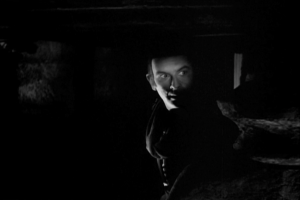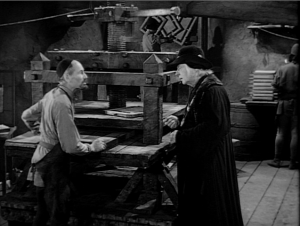So how does the 1939 version of “The Hunchback of Notre Dame” hold up against Victor Hugo’s novel? Well first let’s identify some MAJOR differences.
The First difference is Frollo. Hugo’s Frollo has been spilt into two characters. This was not the first film and certainly not the last film to do this, but to my knowledge it was the first to make him a High Justice and the last to separate him between brothers. If you haven’t read the book, Frollo has a younger brother name Jehan. Jehan is quite licentious while Claude, the older Archdeacon, is the lusty priest. So splitting the Frollo character into brothers isn’t a stretch. The reason why Frollo is spilt into the pious brother and lusty bad younger brother is the same reason why Quasimodo is crowned the “King of Fools” and not the “Pope of Fools”; The Hays Movie Code. The Movie Code (Censorship) that was in affect back in the 30s didn’t allow the church to look bad in any fashion (among other things). I give the film some credit, it tries to remind the viewer that Frollo should be a priest, or at least he wants to be a priest.
ESMERALDA: Who are you? You’re not a priest, and yet you look like one.
FROLLO: I am what I wish to be.
Though him being a priest wanna-be doesn’t make me believe in his torment of “wanting” Esmeralda. Fortunately he doesn’t seem to combat his emotions, he goes from “I want you” to “you must die” in record time and doesn’t think twice. Whereas Hugo’s Frollo runs the gambit of emotions for Esmeralda. Plus it’s not important that he is in deep torment because the film is not really concerned with Frollo, Frollo is a necessary character because he is the catalyst for the story. Without Frollo, the book would have ended with Feast of Fools, the adaptations need him as a character but the lengths of his development are left to film. The ‘39′ Frollo gets some development but not enough. Instead characters that are lesser in significance get push to the forefront due to the next major difference of the movie.
The next big difference is modernity and the conflict between old vs new. The book did have a rather long chapter/essay called “This will Destroy that”(translations may vary) which was about how books will destroy the church and architecture. So instead of the cathedral being the conduit to teach the masses the stories and the history of the christendom, books would take over that role. But the film pushes this way too far and distracts from the main plot, hell the film opens with a scene that rehashes “This will destroy that” just with a positive spin. Also because the film takes a modernity good-old fashion bad, Gringoire, Clopin, and King Louis are made into more prominent characters despite being lesser characters in book especially Louis, whose hardly a character at all.
But these are not the only character that are tweaked. Esmeralda is very different than in the book. In the book she is a naive, innocent, flighty, and pone to giving into whims. She also had a very different back story, a back story that seldom gets into adaptations. The only part of her backstory that can be compared to the book is that she came to Paris on the Feast of Fools in the movie, and in the book she had been in Paris a for over a year and was beloved amongst the people of Paris. In the movie, her motivation is for her people and she has a strong sense of empathy instead of love of dancing. It is interesting to note that when Esmeralda has these characteristic, Frollo is a High Justice who seems to hold more power than the king (in the 39 movie, he rounds up all the Gypsy girls in the Court of Miracles and the Disney he burns all of Paris). I suppose the caring, empathic Esmeralda is a counterpoint to the powerful, racist Frollo, but it’s a striking difference to her character in the book where she is a naive, simple, winsome child, who is unaware of her own charms. The 1939 characterization of Esmeralda she isn’t naive and she does at least in the 39 version, use girlish charms to get Louis to help her. She’s not above turning on the charms to get what she wants but doesn’t do it with Frollo, perhaps she didn’t know Frollo was in a position that could have help her. At least in the book she was afraid of him, hence she didn’t want to have anything to with him. In the 1939 version she doesn’t seem to exhibit any strong feelings towards, she neither likes him nor hates him, but she strikes an accord with him about animals. So I guess she could have turned up the feminine charms towards Frollo had he not been a bigoted pervert. The main reason why Esmeralda is never depicted as she is in the book, is she would come off unlikable, (a shallow, simple, young girl) so the film always has to tweak her character to make her likable. If she cozen up to Frollo, the villain, she wouldn’t have been as likable and has the only main female character, she has to likable.





During the King of Fools contest, the call’s first is Africans, men, women… This isn’t in Hugo. Hollywood racism’s is not new.